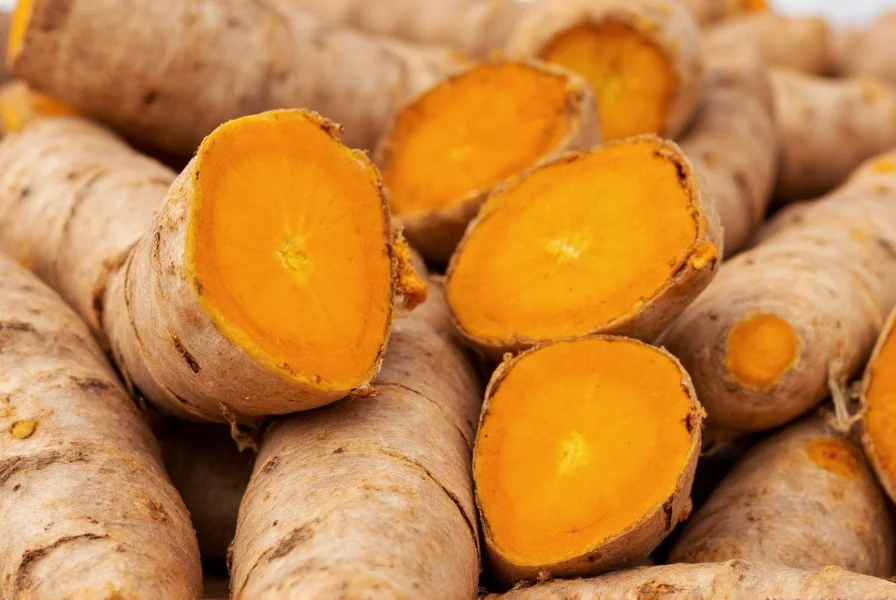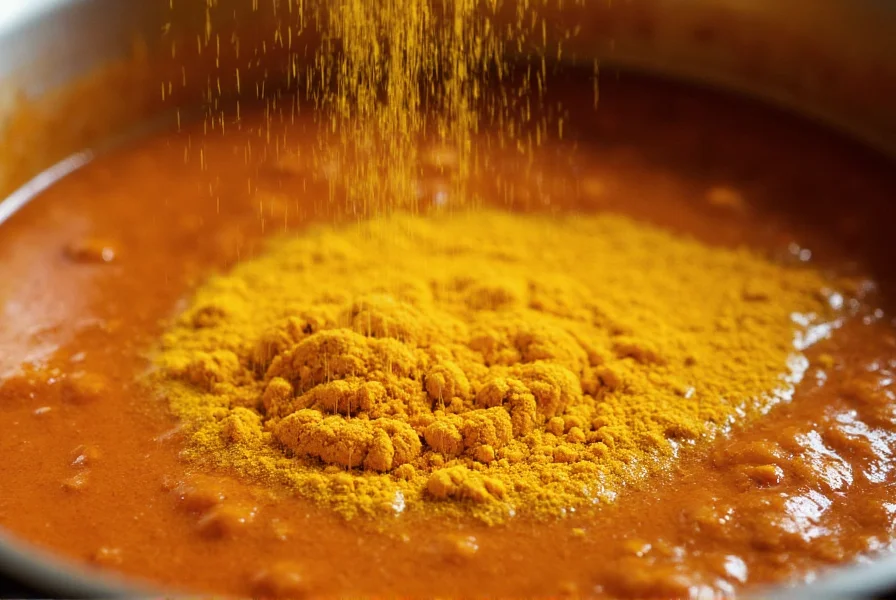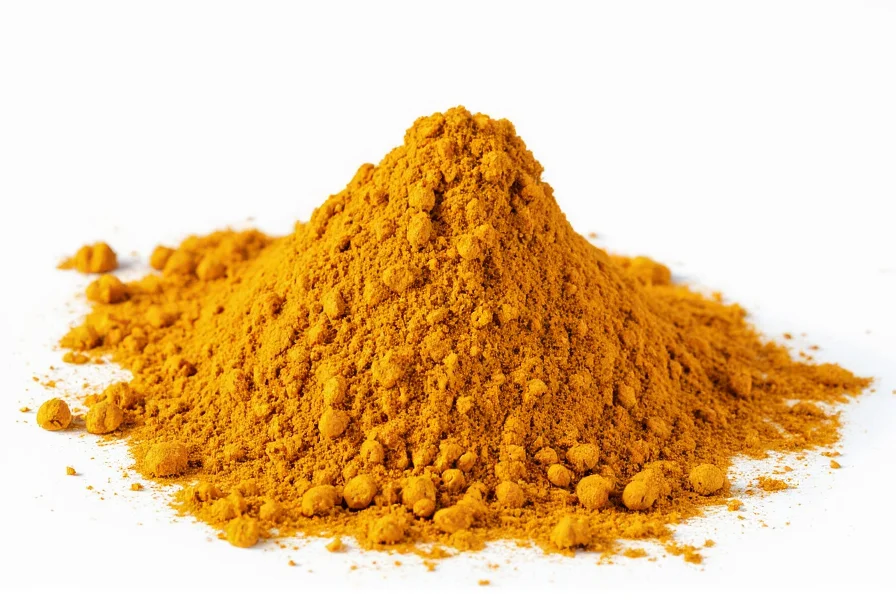Turmeric definition extends beyond its identity as a common kitchen spice. Scientifically classified as Curcuma longa, this ancient botanical specimen belongs to the Zingiberaceae family, sharing genetic relations with ginger, cardamom, and galangal. The plant's distinctive golden-yellow color comes from curcuminoids, with curcumin being the most active compound comprising about 2-8% of raw turmeric rhizomes.
Botanical Classification and Characteristics
Turmeric's precise botanical definition identifies it as a member of the Zingiberaceae family within the Zingiberales order. The plant features:
- Height: 60-100 cm tall with pseudostems formed by leaf sheaths
- Leaves: Large, oblong, and arranged in two rows with prominent central veins
- Flowers: Yellow to white trumpet-shaped blooms appearing on separate shoots
- Rhizomes: Deep orange-yellow when cut, with a tough brown skin when mature
| Botanical Feature | Description |
|---|---|
| Scientific Name | Curcuma longa L. |
| Common Names | Turmeric, Indian saffron, yellow root |
| Rhizome Color | Bright orange-yellow internally |
| Primary Compound | Curcumin (diferuloylmethane) |
| Native Region | Southeast Asia and Indian subcontinent |
Origin and Historical Significance
Archaeological evidence suggests turmeric has been used for over 4,000 years, with origins tracing back to the Indian subcontinent and Southeast Asia. Ancient Sanskrit texts from 500 BCE reference turmeric in religious ceremonies and traditional Ayurvedic medicine. The spice traveled along trade routes to China by 700 CE, East Africa by 800 CE, and West Africa by 1200 CE. Its scientific definition evolved as European botanists documented the plant during colonial explorations, with Carl Linnaeus formally classifying it as Curcuma longa in 1753.

Chemical Composition and Properties
The complete turmeric definition must address its complex chemical profile. Raw turmeric rhizomes contain:
- 3-6% essential oils (ar-turmerone, α-turmerone, β-turmerone)
- 2-8% curcuminoids (curcumin, demethoxycurcumin, bisdemethoxycurcumin)
- 60-70% carbohydrates
- 6-8% protein
- 5-10% moisture
- 5-12% volatile oils
Curcumin, the principal curcuminoid, gives turmeric its characteristic yellow color and accounts for most of its studied biological activities. However, curcumin represents only a fraction of turmeric's composition, explaining why whole turmeric may have different effects than isolated curcumin supplements.
Culinary Applications Worldwide
Understanding the turmeric definition requires examining its global culinary significance. This spice provides:
- Color: Imparts vibrant yellow hue to dishes without strong flavor dominance
- Flavor: Earthy, slightly bitter, with subtle ginger-like warmth
- Preservation: Natural antimicrobial properties extend food shelf life
In Indian cuisine, turmeric forms the base of curry powders and is considered essential in virtually all savory dishes. Southeast Asian cooking uses fresh turmeric rhizomes in soups and marinades, while Middle Eastern and Persian cuisines incorporate it into rice dishes and stews. The spice's heat stability makes it valuable for cooked dishes, though prolonged boiling can degrade curcumin content.

Differentiating Turmeric from Related Terms
Many confuse turmeric with similar terms. Clarifying these distinctions forms an essential part of the turmeric definition:
- Turmeric vs Curcumin: Turmeric refers to the whole plant/spice, while curcumin is a single compound within turmeric
- Turmeric vs Ginger: Both are rhizomes in Zingiberaceae family, but turmeric has yellow-orange flesh versus ginger's pale yellow
- Raw vs Powdered Turmeric: Fresh rhizomes contain higher moisture and volatile oils compared to dried, ground powder
Modern Research and Applications
Contemporary scientific understanding expands the turmeric definition beyond traditional uses. Current research focuses on:
- Anti-inflammatory properties of curcuminoids
- Potential cognitive health benefits
- Natural food coloring applications (E100)
- Textile dyeing and cosmetic formulations
While promising, researchers emphasize that most studies use concentrated extracts rather than culinary amounts. The bioavailability of curcumin remains a challenge, with piperine (from black pepper) shown to enhance absorption by up to 2,000%.
Frequently Asked Questions
What is the scientific name for turmeric?
The scientific name for turmeric is Curcuma longa. This botanical designation distinguishes it from other Curcuma species and provides the precise identification used in scientific research and botanical classification.
Is turmeric a root or a rhizome?
Turmeric is a rhizome, not a true root. Rhizomes are horizontal underground stems that store nutrients and produce new shoots. The turmeric rhizome has distinct nodes and internodes, characteristic of stem tissue, unlike true roots which lack these structures.
What gives turmeric its yellow color?
Turmeric's vibrant yellow-orange color comes primarily from curcuminoids, with curcumin (diferuloylmethane) being the most abundant. These compounds make up 2-8% of raw turmeric and are responsible for both the color and many of the studied biological properties of the spice.
How is turmeric different from curry powder?
Turmeric is a single spice derived from Curcuma longa rhizomes, while curry powder is a blend of multiple spices that typically includes turmeric as a primary ingredient. Curry powder formulations vary but commonly contain coriander, cumin, fenugreek, and chili peppers in addition to turmeric.











 浙公网安备
33010002000092号
浙公网安备
33010002000092号 浙B2-20120091-4
浙B2-20120091-4